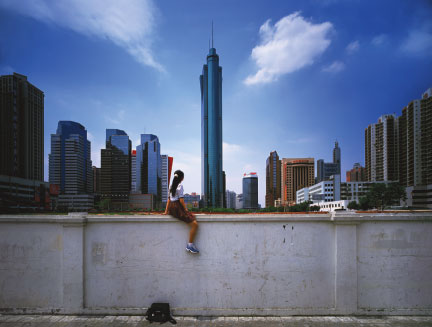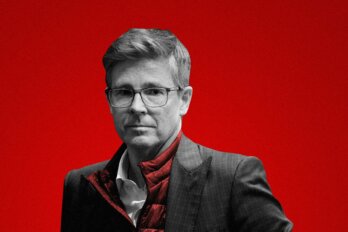On a busy shopping street in Hong Kong, in the shadow of Armani’s opaque flagship store, within a stone’s throw of Versace, Gucci, Louis Vuitton, and Ralph Lauren, was this image: a beautiful, expensively dressed young mother placidly holding open a white Bulgari shopping bag for her six-year-old son to vomit into. It was a snapshot that captured a civic mood. A certain malaise has pervaded the city since the sars outbreak, as a result of growing fear of infectious disease, a volatile stock market, and an uncertain political future. When Chinese leaders in Beijing declared that they would decide who was sufficiently patriotic to govern Hong Kong, an Orwellian discourse flowered on the subject of who was more qualified. The word “patriotic” assumed some of the dark energy it possessed during Mao’s rule.
A Hong Kong developer said, “I don’t think we have a sense of being part of our country.” He questioned whether nationalism was possible in Hong Kong, which exists as something between a city, a territory, and an investment website. It is capitalism reduced to its essence, purer than America’s capitalism, purer even than the mythic Horatio Alger brand. Historically, Hong Kong has been seen as apolitical, a place where the citizens merely wanted to be left alone to make money. Nationalism was an abstraction. I had lunch with a woman who said she had difficulty defining her nationality. She used to refer to herself as British, then as a Hong Kong citizen, and now tentatively as Chinese. She has been searching for cultural touchstones, ways to connect to the mainland and her distant heritage. At the same time, the mainland is marching away from its heritage toward Hong Kong’s unfettered capitalism, using the late paramount leader Deng Xiaoping’s exhortation — “To get rich is glorious” — as a slogan.
The place where these two ideas meet is the Shenzhen River, which separates Hong Kong’s New Territories from the city of Shenzhen. Deng thought Shenzhen and Hong Kong would become twin cities and would compensate for each other’s weaknesses. In 1980, Shenzhen was a fishing village, home to 25,000 people, and the tallest building was four storeys. Now it has eight million people, with three million of them classified as transients, largely peasants from the Pearl River Delta. The urbanization of China represents the largest migration in history. Currently 60 percent of the Chinese population — 800 million people — live on small farms and earn a third of what those in cities earn. As farm workers everywhere have done for generations, they are heading for the big city. The United Nations predicts that by 2030, 60 percent of the population will live in cities. (In Canada, the 1931 census was the first to show a majority of the population was urban). As this trend accelerates, the cities will continue to evolve, both culturally and as experiments in urban planning.
But the growth of Shenzhen has the added variable of merging with another city that is historically and temperamentally very different. Shenzhen residents are eager to see the border completely erased, to have access to the capitalist motherlode. But Hong Kong residents fear the invasion of mainland Chinese as the border relaxes; they see Shenzhen as the barbarians at the gate.
Deng’s twin cities are merging into one, a megalopolis that is becoming ground zero for global economic activity, a massive manufacturing centre that contains two of the largest container ports in the world and could have thirty million inhabitants within a decade. What kind of city will this be? At this early stage, Hong Kong and Shenzhen are like the bride and groom in an arranged marriage, with neither one capable of giving the other what it wants. They may be forming a kind of twenty-first-century prototype, a Blade Runner community bound not by culture or politics but by mutual suspicions, simple geography, and brand names.
An architectural tour of Hong Kong features a few of the white colonial buildings that the British have abandoned around the globe, but focuses mostly on the celebrity high-rises that fill the familiar skyline. The world’s first $1-billion (US) building was Norman Foster’s Hongkong and Shanghai Banking Corporation headquarters, its dark exoskeleton occasionally seen in films. It is flanked by I.M. Pei’s elegant Bank of China and Cesar Pelli’s International Finance Centre. There is also Norman Foster’s $20-billion airport and his proposed cultural centre. The city invites ambition and, occasionally, excess; there are proposals for even taller buildings to grace a skyline that is as much about advertising as urban planning.
From Kowloon, it is only a forty-five-minute train ride to Shenzhen, moving through the New Territories, past clusters of identical fifty-five-storey high-rises that look like unnatural crystal formations pushing out of the earth. Sometimes there are thirty of them in a huddle, a continuation of Hong Kong’s aggressive verticality. A thousand metres away is another huddle, forming an archipelago that links the two cities.
Shenzhen was the first of Deng Xiaoping’s Special Economic Zones, designed to bridge the gap between China and the rest of the world. “Special Economic Zones are a window to technology, management, knowledge, and foreign policies,” he said. “[They] will become a foundation for opening to the outside world.” Within China’s socialist economy, Shenzhen was conceived as an economic experiment, one that was initially conducted in isolation, with the border sealed by barbed wire. The rate of growth was much faster than anticipated — the government predicted a population of roughly eight million by 2020 — and now the infrastructure is overtaxed and the police force, designed for 1.4 million citizens, is overwhelmed. It is Shenzhen’s perceived lawlessness, as much as anything, that has made orderly Hong Kong residents nervous.
The average age in Shenzhen is twenty-eight and, like youth itself, the city exists almost solely in the present. People come to boom towns to reinvent themselves, to escape the past. When I went into the Shenzhen Museum, I was the only visitor, and the guard was asleep. The roads are clogged with the new foreign cars of those who have made good, and the odd Beverly Hillbillies van loaded with furniture and hopeful arrivals.
Like so much in Communist China, Shenzhen was launched with a slogan: “Three Paths and One Levelling.” The levelling refers to the original village, and the three paths are the east/west highways that run in parallel across the city. Deng wanted Shenzhen to be an “International Garden City” that would show the world that China could do modernity with élan. The socialist planners saw utopian possibilities, but the first two master plans, conceived in 1982 and 1984, were both overrun by the realities of free market development.
Hong Kong’s relentless consumerism is reflected here in a funhouse mirror kind of way, with Hong Kong’s small, elegant boutiques and narrow streets replaced in Shenzhen by suburban big-box retailing on Brobdingnagian avenues. The sidewalks on Shenzhen’s Renminnan Road are incredibly wide and double-lined with trees, and the stores are massive, divided into blunt categories: Men’s World, Women’s World, Children’s World, Technology World. The fringes, as in Hong Kong, are filled with small business: kiosks selling grilled meat, postcards, stuffed animals, underwear; an elderly man in a brown suit selling pornographic dvds out of a gym bag. Mountains loom in the haze at the north end of the street, and people flow into and out of the stores, weighing the authenticity of the wares. Like Hong Kong before it, Shenzhen specializes in knock-offs. Technology and fashion are copied before the original products even hit the stores, and pirated dvds surface before a film’s premiere. There is a whole mall dedicated to copies. The civic catchphrase, captured on a banner in the Shenzhen Museum, is, “Pioneering Initiation for the Second Time.” Shenzhen celebrates imitation.
The city was built quickly and cheaply, giving it a sense of being both ephemeral and artificial. Within a decade, there were 300 skyscrapers. Architects finished the designs and drawings for some high-rises in seven days. Blueprints were sold or pirated, and buildings were knocked off like Calvin Klein jeans, with a few new details to distinguish them. Why pay for celebrity when you can recreate it for a fraction of the price?
Many of the surrounding residential buildings already appear worn and dated. The facades are rust-stained from the air conditioners that perch at every window on steel struts. On the sides of some buildings banners are hung with a pouting ten-storey face selling lipstick or an unshaven cowboy selling jeans. There is protective metal grille work over the windows, even twenty storeys up, as a hedge against thieves.
Architecture in Shenzhen has become something that is less concerned with the notional ideas of shelter and aesthetics and more closely resembles pork belly futures. It is a commodity that is bought, traded, and stolen, one whose primary function is a return on investment. The downtown, which was centred around the original village of Luohu, is now being moved by government dictate. The result is a fevered cycle of investment and construction at the new site and a languishing of the existing downtown. Urban cycles of decay and resurrection that take generations to play out in North American cities accelerate to a few years here. Like Los Angeles, Shenzhen seems to have no centre. High-rises have been razed after barely a decade to make way for more promising investments. In some ways, the city is trying to knock off Hong Kong, and it is Hong Kong money that is largely financing it.
I was staying in Overseas Chinese Town, conceived as a showpiece bloc within the showpiece city. It was designed for returning Chinese nationals to be both a model residential area and the city’s official tourist district. In my business hotel, a dozen nationalities sat restlessly in the restaurant each night eating the delicacies — “traditional sliced ham spaghetti soup” to name one — that had been created to make foreigners feel at home. They nursed their expensive scotches and looked out at the vast awakening market, staring with the slack, anxious faces of men watching pornography. Here was a consumer Frankenstein, teeming millions waking up to the promise of Buicks and McDonald’s, lurching through the marketplace, sucking up the latest technology and fashions. Behind them the global villagers run, bearing torches and co-production deals. Every morning chartered buses pulled up to the hotel and the dark-suited salespeople were taken away, returning at nightfall. A Hong Kong businesswoman told me that insurance was one of the fastest growth industries in Shenzhen. A foreign concept, it now struck a chord, mitigating the dangers of urban life.
On a blue morning, the air soft and still unladen with the day’s particulates, you could glimpse the utopian city that planners had imagined. On each side of busy Shennan Road, there are broad, graceful promenades that are lined with trees and filled with students walking arm in arm. A huge contiguous park features large plazas, serene Oriental pools, raw forest, and sculpted gardens. It sits in the shade of a monolithic Wal-Mart, a company that grows at the same rapacious rate as the city, which has embraced it as kin. (The first Wal-Mart in China was built in Shenzhen, a beachhead established in 1996.) A group of fifty women are exercising in the park, moving rhythmically to upbeat music. Behind them is a concrete cube with a small hole in it. A discreet sign reads, “If you are not well, just shout at me.” It is an art installation titled Comfort Hole; the idea is that you shout your demons into the hole and they become imprisoned in the cube. Beside it is a large smooth slate plaza where a small army of men wearing bright green grocer smocks perform Tai Chi. A ballroom dance class is underway in another plaza. It is 7:45 a.m.
Across the road are two massive theme parks, Window of the World and Splendid China. The former features miniatures of the world’s great monuments. The first park had a certain appeal when no one could leave China, but it has diminishing currency as the border becomes more porous. Splendid China has most of the country’s wonders reduced to scale and it too is sparsely populated. The Chinese government opened a second version of Splendid China in Florida, near Disney World in 1993, but it closed ten years later when attendance dwindled to a few hundred visitors a day. There is an unwanted earnestness to their theme parks (among Shenzhen’s other theme parks is Minsk World, dedicated to a decommissioned Russian aircraft carrier). Rather than creating fantasy, they are knocking off reality.
An hour away, near the Hong Kong airport, Disney’s newest theme park is finished, and the shadow of that threatening mouse hangs over the land. A monorail runs through Overseas Chinese Town, and from its perch I could look down to the midway of Happy Valley, a children’s amusement park, where I was reminded that this is a nation defined by the only child.
The group that built Overseas Chinese Town is planning another version on the opposite side of the city, on the east coast near Yantian. Above the beautifully groomed beach there, beyond the McDonald’s, the kfc, and the Feeling Party Bar, hundreds of expensive condos have been carved into the mountains. An official told me that the new Overseas Chinese Town is going to be a “major international city, a beautiful seashore resort.” It will have beaches and a marina; it will be a showcase to the world. And what of the old Overseas Chinese Town? Presumably it will quietly wither, its theme parks eventually razed to make something fresher and more profitable. Another decade, another showcase.
The Diwang (King of Land) Mansion is Shenzhen’s tallest building at 384 metres — negligible by Hong Kong standards, but with claims to being the fastest high-rise ever built. (A new storey was added every two-and-a-half days.) On the top floor there is an observation area with video games and life-sized wax statues of Deng Xiaoping and Margaret Thatcher sitting down to tea. Looking south, I could see Hong Kong’s New Territories, a quilt of what were once rice paddies and are now mostly fish farms. There are some hills to the south, denuded of foliage, which was burned off to spot Chinese nationals illegally fleeing to Hong Kong. Now there are daily commuters, people who work in Hong Kong but live in Shenzhen, where housing is a fraction of the cost.
Shenzhen is usurping some of Hong Kong’s traditional roles. The factories, with their attendant pollution and cheap labour, have now moved north. Professor Yang Lixun, a member of the Shenzhen Communist Party Committee, admitted that the city was growing too fast. The way to control growth, he said, was to move the factories outside Shenzhen. Hong Kong had downloaded this job to Shenzhen, and now Shenzhen must find a growing, needy city to accept its tired, its poor, its huddled knock-offs.
Hong Kong’s traditional role as broker between the mainland and the outside world is also being eroded by Shenzhen, as business people increasingly go directly to the mainland. And it is largely Hong Kong money that is fuelling the monster, bringing Shenzhen closer every day. Such is the nature of capitalism; it doesn’t realize it has consumed itself until everything goes dark.






